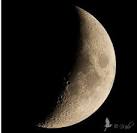The Moon
The Moon, of course, has been known since prehistoric
times.  The Moon is the second brightest object in the sky after the
The Moon is the second brightest object in the sky after the
Sun. As the Moon orbits around the Earth once per month,
the angle between the Earth, the Moon and the Sun changes;
we see this as the cycle of the Moon 's phases. The time
between successive new moons is 29.5 days (709 hours),
slightly different from the Moon's orbital period (measured
against the stars) since the Earth moves a significant
distance in its orbit around the Sun in that time.
Due to its size and composition, the Moon is sometimes
classified as a terrestrial "planet" along with Mercury, Venus,
Earth and Mars .
The Moon was first visited by the
Soviet spacecraft Luna 2 in 1959. It is
the only extraterrestrial body to have
been visited by humans. The first
landing was on July 20, 1969 (do you
remember where you were?); the last
was in December 1972. The Moon is
also the only body from which samples
have been returned to Earth. In the
summer of 1994, the Moon was very extensively mapped by
the little spacecraft Clementine and again in 1999 by Lunar
Prospector .
The gravitational forces between the Earth and the Moon
cause some interesting effects. The most obvious is the
tides. The Moon's gravitational attraction is stronger on the
side of the Earth nearest to the Moon and weaker on the
opposite side. Since the Earth, and particularly the oceans,
is not perfectly rigid it is stretched out along the line toward
the Moon. From our perspective on the Earth's surface we
see two small bulges, one in the direction of the Moon and
one directly opposite. The effect is much stronger in the
ocean water than in the solid crust so the water bulges are
higher. And because the Earth rotates much faster than the
Moon moves in its orbit, the bulges move around the Earth
about once a day giving two high tides per day. (This is a
greatly simplified model; actual tides, especially near the
coasts, are much more complicated.)
But the Earth is not completely
fluid, either. The Earth's rotation
carries the Earth's bulges
slightly ahead of the point
directly beneath the Moon. This
means that the force between
the Earth and the Moon is not
exactly along the line between their centers producing a
torque on the Earth and an accelerating force on the Moon.